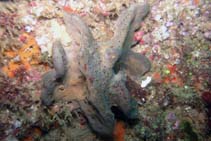Spongia agaricina Pallas, 1766
| Native range | All suitable habitat | Point map | Year 2050 |

|
| This map was computer-generated and has not yet been reviewed. |
| Spongia agaricina AquaMaps Data sources: GBIF OBIS |
Classification / Names Common names | Synonyms | CoL | ITIS | WoRMS
| Dictyoceratida | Spongiidae
Environment: milieu / climate zone / depth range / distribution range Ekologi
; kisaran kedalaman 4 - 100 m (Ref. 363), usually 4 - 60 m (Ref. 363). Subtropical
Penyebaran Negara-negara | Daerah-daerah FAO | Ecosystems | Kemunculan | Introduksi
Northeast Atlantic and Mediterranean.
Length at first maturity / Size / Weight / umur
Maturity: Lm ? range ? - ? cm Max length : 100.0 cm WD jantan/; (Ref. 363)
deskripsi pendek Morfologi
Sponge out of thick blade: 0.6 to 2 cm; sometimes cut out or folded up on it, often forming a more or less complete cut. One of the faces, the intern on the specimens out of cut, carries many osculus of small size, rather regularly laid out, towards which converge of small exhaling channels surface. Conules: small size; rather regular. Ectosome often reinforced by an arenaceous network. Composite primary fibers: 5 - 8 cm diameter; with foreign bodies. Secondary fibers: 0.0025 to 0.0035 cm; with sometimes a fine fiber network from 0.0006 to 0.001 cm on the surface. Color: dark gray with more or less dark chestnut.
Species very good fair average quality, formerly much used in industry (polishing of the ices). Restricted production; collected at decorative ends (Ref. 363). Association: Often parasitized by the cirripède Acasta spongites (Ref. 363).
Life cycle and mating behavior Kematangan | Reproduksi, perkembang biakan | Pemijahan | telur-telur | Fecundity | Larva
Members of the class Demospongiae are hermaphroditic. Life cycle: The zygote develops into parenchymella larva (free-swimming) before settling down on a substrate where it grows into a young sponge.
rujukan utama
Acuan | Koordinator | mitra
Vacelet, J. 1987. (Ref. 363)
Status IUCN Red List (Ref. 130435)
status CITES (Ref. 108899)
Not Evaluated
CMS (Ref. 116361)
Not Evaluated
ancaman kepada manusia
Harmless
penggunaan manusia
Perikanan: bernilai komersial tinggi
| FishSource |
Alat, peralatan
informasi lanjut
Nama-nama umum
Sinonim (persamaan)
Pemangsa
Reproduksi, perkembang biakan
Kematangan
Pemijahan
Fecundity
telur-telur
pekembangan telor
Sinonim (persamaan)
Pemangsa
Reproduksi, perkembang biakan
Kematangan
Pemijahan
Fecundity
telur-telur
pekembangan telor
Sumber internet
BHL | BOLD Systems | CISTI | DiscoverLife | FAO(Publication : search) | Fishipedia | GenBank (genom, Nukleotida) | GloBI | Gomexsi | Google Books | Google Scholar | Google | PubMed | Tree of Life | Wikipedia (pergi, Cari) | Zoological Record
Estimates based on models
Preferred temperature
(Ref. 115969): 14.3 - 21.6, mean 18.3 (based on 268 cells).
kategori harga
(Ref. 80766):
Unknown.



